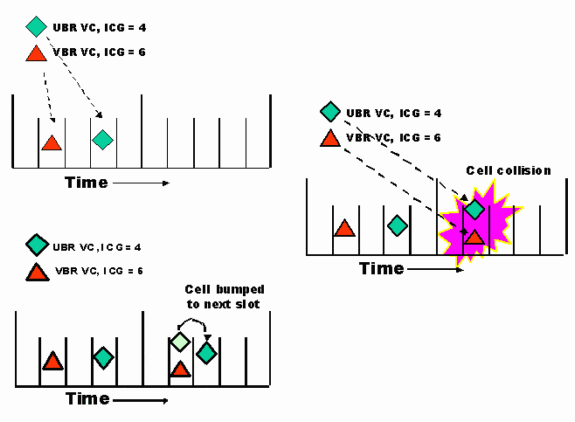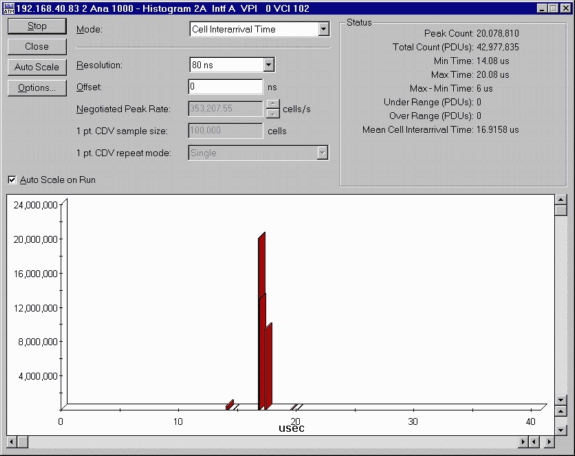Understanding Router Support for ATM Real-Time Service Categories
Available Languages
Contents
Introduction
With the increased popularity of multiservice applications, ATM real-time connections (constant bit rate [CBR] and Variable Bit Rate Real Time [VBR-rt]) are becoming a more common transport choice for network managers. This document discusses some key concepts that are important in understanding how a router can support these real-time service categories.
Prerequisites
Requirements
There are no specific requirements for this document.
Components Used
This document is not restricted to specific software and hardware versions.
Conventions
For more information on document conventions, refer to the Cisco Technical Tips Conventions.
Service Categories, Traffic and QoS Parameters
The ATM Forum Traffic Management Specification 4.1 (TM 4.1) defines CBR and VBR-rt as "intended for voice and video applications that require tightly constrained delay and delay variation." While compressed voice and video flows are the ideal application for VBR-rt, the main purpose of CBR is transport of circuit-emulation services.
The first important concept to understand is that TM 4.1, as well other ATM standards, discusses service aspects exclusively related to the ATM network. According to TM 4.1:
-
"A network may support one or more performance objectives for each of the Quality of Service (QoS) parameters. For each direction of a connection, a specific QoS is negotiated among the network(s) and the end-systems. The network agrees to meet or exceed the negotiated QoS as long as the end-system complies with the negotiated traffic contract."
In ATM Forum terminology, a router is an end-system, that is, the device where cells are sourced and terminated (SAR process), as opposed to being switched by ATM nodes and networks. The important implication of the paragraph quoted above is that the only obligation a router has to the ATM network is compliance with the negotiated traffic contract and its parameters, no matter what the service category used.
Consequently, router support for different service categories can be grouped simply by the pertinent traffic parameters, Peak Cell Rate (PCR), Sustainable Cell Rate (SCR), Maximum Burst Size (MBS), and Minimum Cell Rate (MCR), as shown in this table:
| Service Category | End-system Applicable Traffic Parameters |
|---|---|
| CBR, UBR, UBR+ | PCR |
| VBR-rt, VBR-nrt | PCR, SCR, MBS |
| ABR | PCR, MCR |
Note: The UBR+ has been categorized together with UBR because in the Cisco router implementation, the actual shaping rate is never changed to MCR, hence this parameter has merely an informative function.
Another traffic parameter related to the above is the Cell Delay Variation Tolerance (CDVT). This parameter measures the tolerance level a network interface has to aggressive sending (back-to-back or very closely spaced cells) by a connected device, and does not apply to end-systems. TM 4.1 also defines an additional set of QoS parameters. Of these, the most important are:
-
Peak-to-peak Cell Delay Variation (peak-to-peak CDV)
-
Maximum Cell Transfer Delay (max CTD)
-
Cell Loss Ratio (CLR)
TM 4.1 states these performance parameters to apply exclusively to the ATM network and not to the router:
-
"The ATM layer Quality of Service (QoS) is measured by a set of parameters characterizing the performance of an ATM layer connection. These QoS parameters quantify end-to-end network performance at the ATM layer."
Any router ATM interface designed for WAN applications supports at least the first two "classes" in the table above. The router perfectly complies with the ATM traffic contract as long it transmits cells at the correct rate determined by the Segmentation and Reassembly (SAR) scheduler. It is then the sole responsibility of the ATM network to ensure that cells sent on a real-time VC have an expedited delivery time.
In light of this, when the router does not have an explicit configuration syntax for CBR, in order to comply with the traffic contract, the user can configure either an unspecified bit rate (UBR) connection with the desired PCR, or a VBR connection with PCR=SCR (the MBS has no influence). Similarly, to use a VBR-rt connection, it is enough to configure it on the router as "regular" or VBR-nrt.
When an ATM interface has a single VC configured, or even when it has multiple VCs that are totally homogeneous in terms of carried traffic type (for example, VCs connecting core routers with a Layer-3 QoS configuration), it does not really matter what the choice is on the configuration explained above. Choosing the exact service category may assume significance only when different traffic types are carried on different VCs, and VC-level prioritization is needed, as explained in the next section.
Router SAR Scheduler and VC Prioritization
When an ATM interface is configured with multiple VCs, and two or more of these are actively transmitting at the same time, there is a possibility that the SAR scheduler may try to transmit two cells at the same time (that is, in the same cell-slot), based on the ideal cell rate for the two VCs. This event is called a "collision," and its probability is proportional to the number of VCs transmitting simultaneously and their rate in relation to the physical line speed.
When a cell collision happens, an implementation-specific prioritization scheme needs to decide which VC will transmit a cell at a time that attains ideal rate, and which one will have it "bumped" to the next cell-slot, where potentially another collision could occur. Under extreme conditions, (that is, when the link is overbooked), a robust SAR implementation never drops cells at the transmitting interface. Instead, the "starving" VC simply transmits cells very slowly, or does not transmit at all. This is illustrated in this figure:

No standard dictates how an end-system should behave in such cases, and everything is left to the implementation. It is intuitive that VCs from real-time class should be serviced first, so that their jitter and likeliness of exceeding CDVT at the ingress of the ATM network are minimized. But when the competing VCs are of the same service category, a further tiebreaker level must be used. This could be a priority associated with the VCs, as discussed in the next section.
Cisco PA-A3 Implementation
The Enhanced ATM port adapter (PA-A3) is the most versatile and widely used high-end router interface to ATM networks. Initially developed for the Cisco 7500 and 7200 router series, it also supported on the Cisco 7600 Optical Services Router (OSR) FlexWan. It is one of the Cisco router ATM interfaces that offers an explicit CLI to configure CBR and VBR-rt connections.
Before the release of Cisco IOS® Software Release 12.2(5) and derived versions, the software driver and firmware for the PA-A3 did not support such explicit commands, and the firmware scheduler implemented a user-definable, four-level VC prioritization mechanism. The changes made with Cisco Bug ID CSCdv04389 (registered customers only) for the 7200 Series and CSCdv84038 (registered customers only) for the 7500 Series have enabled CLI-level support for CBR and VBR-rt, furthermore increasing to six the priorities used as tiebreaker in case of cell collision. By default (user tuning is always possible with the priority command), these priorities are now:
-
0 CBR, Control
-
1 AAL5 or AAL2 VoATM VC (any service category)
-
2 Real-timeVBR
-
3 Non real-timeVBR
-
4 ABR
-
5 UBR, UBR+
These changes, however, did not affect at all the existing scheduler functionality, so that, as already discussed, CBR and VBR-rt connections can also be used with older software versions.
It is worth noting that the design and maturity of the PA-A3 port adapter allows the platforms using it to attain an unsurpassed level of stability, feature richness, and performance in all the applications. As an example, the following snapshot, taken with an ATM traffic analyzer, shows the excellent level of shaping accuracy. During the test shown in the following figure, the router is sending multiple VCs of different traffic categories on an overbooked OC-3 interface. In all test cases, the highest-priority CBR VC maintained a jitter-free cell interarrival time and never suffered cell drop at the source like the lower-priority VCs.

PVC and SVC Implications
With ATM permanent virtual circuits (PVCs), the router and the ATM network are totally unaware of the traffic parameters applied by the other entity. In some cases, this allows you to purposely configure mismatching traffic parameters or service categories, as described in the preceding paragraphs. However, when using switched virtual circuits (SVCs), the ATM network exchanges traffic parameters information with the end-system, so both must be prepared and configured to specifically support the desired traffic options. For this exchange to complete successfully, in case of real-time connections, the router must support the explicit CBR and VBR-rt CLI previously described.
Conclusion
When using ATM PVC, CBR and VBR-rt connections are immediately usable on any Cisco router that supports VBR. Depending on the specific platform and software level, an explicit command-line support may or may not be present. Correct operation with SVCs instead requires CLI support for these real-time service categories.
Related Information
Contact Cisco
- Open a Support Case

- (Requires a Cisco Service Contract)
 Feedback
Feedback